#king joão ii of portugal
Explore tagged Tumblr posts
Text
Parallels between D. Pedro I of Portugal, "The Cruel" and Rhaenyra Targaryen "The Cruel".

As we know... Rhaenyra Targaryen, a character from George R.R. Martin's "A Song of Ice and Fire" series, and D. Pedro I of Portugal, a historical figure, share some parallels which i find extremely interesting!
Loss of their loved ones :
Rhaenyra Targaryen and D. Pedro I of Portugal experienced heart-wrenching losses that led to civil wars against their own family.
Rhaenyra Targaryen : Rhaenyra lost her son, Prince Lucerys Velaryon, by her half-brother Aegon II's supporters. These tragedie fueled Rhaenyra's determination to claim the Iron Throne, leading to the devastating civil war known as the Dance of the Dragons, where she fought against her half-brother and his supporters for control of the Seven Kingdoms. D. Pedro I of Portugal : Pedro's love for his mistress, Inês de Castro, led to a tragic turn of events. His father, King Afonso IV of Portugal, disapproved of Pedro's relationship with Inês and ordered her assassination in 1355. This brutal act led Pedro to rebel against his father, sparking a civil war known as the Crisis of 1383–1385. Pedro sought vengeance for Inês's murder and contested his father's authority, ultimately leading to the overthrow of the Portuguese monarchy and the establishment of Pedro as King D. Pedro I of Portugal. Both Rhaenyra and D. Pedro I's civil wars were deeply personal, fueled by love, loss, and a desire for justice or vengeance against their own family members. These conflicts underscored the complexities of power struggles within ruling families and the lengths individuals would go to in order to protect their loved ones and assert their rightful claims.
Struggles for Succession :
Both Rhaenyra and D. Pedro I faced challenges regarding succession.
Rhaenyra Targaryen : she fought to claim the Iron Throne of Westeros, facing opposition from her half-brother, Aegon II.
D. Pedro I of Portugal : was involved in a struggle for succession in Portugal, particularly against his father, King D. João VI, and his father's supporters.
Family Conflicts :
Both figures were embroiled in familial conflicts.
Rhaenyra Targaryen : Rhaenyra's claim to the throne sparked a civil war known as the Dance of the Dragons, pitting different branches of House Targaryen against each other.
D. Pedro I of Portugal : Pedro faced tensions within his own family, including conflicts with his father, as well as disputes with his wife, Infanta Carlota Joaquina.
Assertive Actions :
Rhaenyra and D. Pedro I both took assertive actions to secure their positions.
Rhaenyra Targaryen : Rhaenyra actively sought allies and military support to strengthen her claim to the throne.
D. Pedro I of Portugal : D. Pedro I engaged in strategic maneuvers and military actions to consolidate his power and assert his authority, notably during the Liberal Wars in Portugal.
Controversial Reigns :
Both figures had controversial reigns marked by conflict and instability.
Rhaenyra Targaryen : Rhaenyra's reign as queen was short-lived and tumultuous, characterized by the civil war that erupted over her claim to the throne.
D. Pedro I of Portugal : D. Pedro I's reign in Portugal was also marked by political unrest and conflict, including his involvement in the Liberal Wars and the struggle to establish a stable government.
The title "The Cruel" :
"The Cruel" as been associated with both Rhaenyra Targaryen and D. Pedro I of Portugal, though in different contexts.
Rhaenyra Targaryen : In George R.R. Martin's "A Song of Ice and Fire" series, Rhaenyra Targaryen is sometimes referred to as "Rhaenyra the Cruel." This epithet reflects her actions during the Targaryen civil war known as the Dance of the Dragons, where she displayed ruthlessness and brutality in her pursuit of power.
D. Pedro I of Portugal : Pedro I of Portugal is also known by the epithet "Pedro the Cruel" or "Pedro the Just." This title stems from his actions during the Crisis of 1383–1385, particularly his ruthless pursuit of vengeance for the murder of his beloved Inês de Castro. Pedro's actions during this time, including the execution of political opponents and enemies, earned him a reputation for cruelty among some contemporaries.
While Rhaenyra Targaryen is a fictional character and D. Pedro I of Portugal was a historical figure, their stories share intriguing parallels in terms of their struggles for power, familial conflicts, and controversial reigns.
I found this quite interesting, I hope you found it interesting too. 😁
#asoiaf#a song of ice and fire#a son for a son#rhaenyra targaryen#house targaryen#house of the dragon#hotd#game of thrones#got#daemon targaryen#lucerys velaryon#D.Pedro#Portugal#history
24 notes
·
View notes
Text
A compendium of references to Portugal in Japanese video games
The beginning of the historical relations between Portugal and Japan dates to the year 1541, when a Portuguese ship washed ashore at Jingujiura. Nearly sixty Japanese words are of Portuguese origin. A variety of Japanese traditions and culinary delights were introduced by Portuguese traders, sailors and missionaries. But in what way has this cultural exchange extended to the more recent phenomenon of Japanese digital games? As a portuguese devotee of Japanese culture, the topic seemed relevant enough to merit some additional exploration.

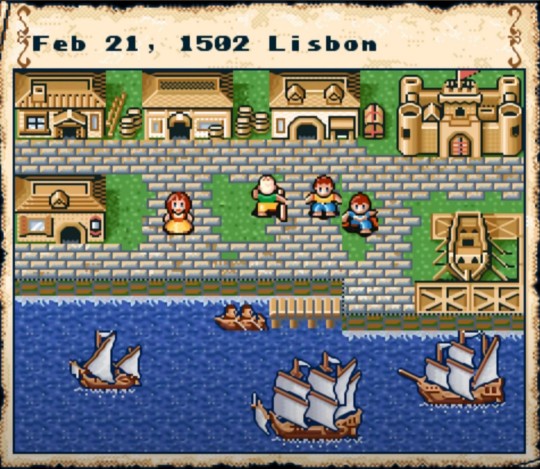
To my knowledge, the first significant reference to Portugal in Japanese video game is found in Koei's The Age of Discovery from 1990, a game published in the west under the title Uncharted Waters. The main character is a disgraced Portuguese nobleman named Leon Ferrero who resorts to maritime exploration, trade and naval warfare to restore his family's good name and prestige.
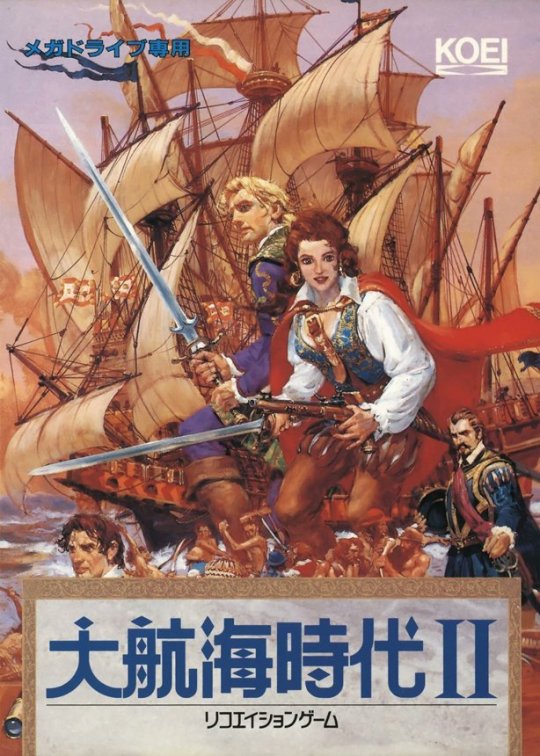
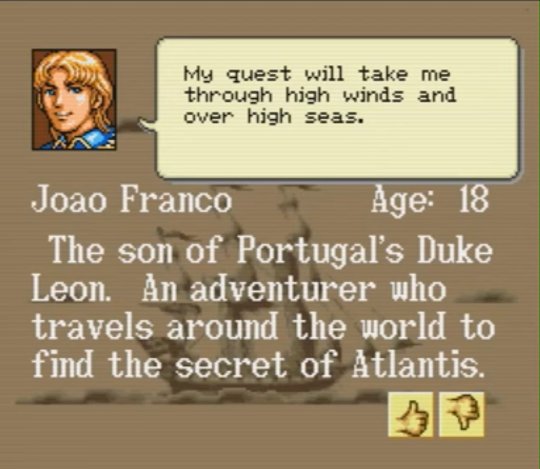
Its 1993 sequel, known in the west as New Horizons, diversifies the base game structure of the original by including multiple characters to select from, each with their own story and mission. Among them is the tale of João Franco, the son of the original episode's protagonist Leon, who sets out to discover the mysterious location of the fabled Atlantis, no less.
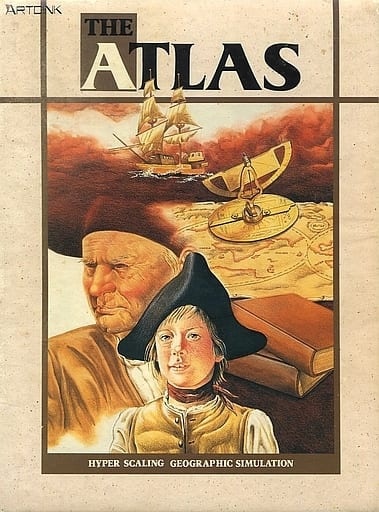
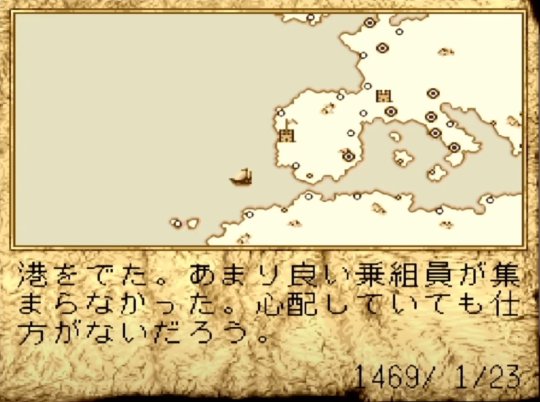
Another meaningful reference can be found a year later in ArtDink's 1991 strategy game The Atlas, in which the player takes on the role of a 15th century explorer with a five year contract with the King of Portugal to discover and chart lands around the Iberian Peninsula.
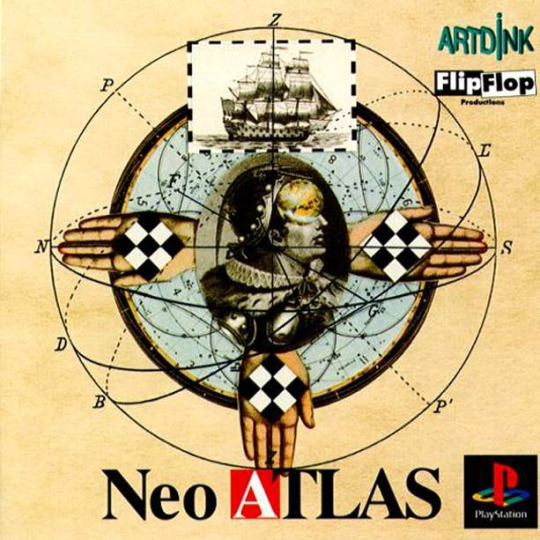
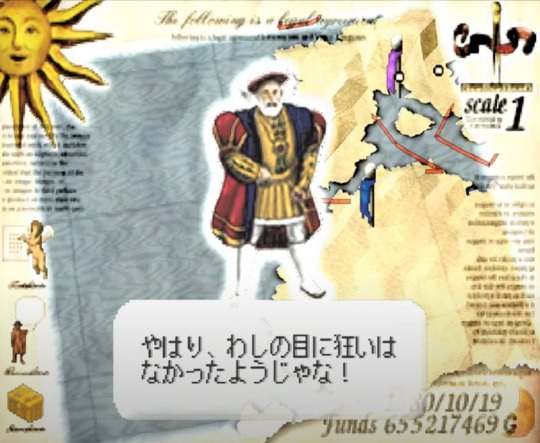
In 1998, ArtDink recreated the game for contemporary systems and published as Neo Atlas. The protagonist is a Portuguese trading company owner seeking business expansion opportunities in remote territories, as well as discover and chart hitherto unknown parts of the globe. A similar premise is found in a later sequel, Neo Atlas III.
Apart from nautical strategy games, a few other titles exist where mentions to the Portuguese territory, language and culture can be traced.
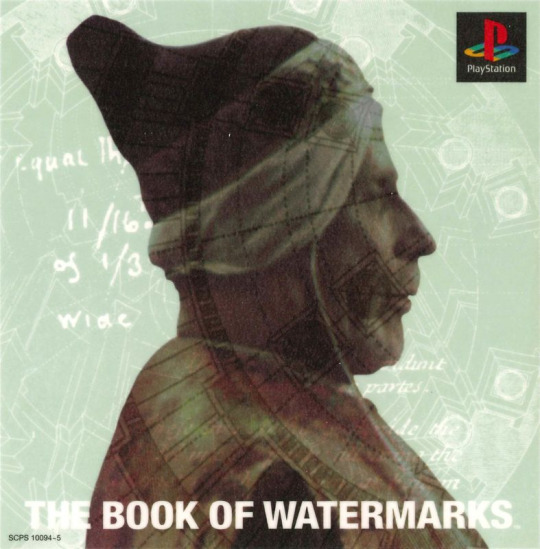
Galvanized by the success of Cyan's world-renowned point and click adventure CD-ROMs, Sony Computer Entertainment helped to publish The Book of Watermarks, a game designed by a miniscule Tokyo-based studio named Watermarks that is brimming with interesting first and second-hand references to Shakespeare's The Tempest. The objective of this visually impressive pre-rendered journey is to aid in the recovery of a series of ancient tomes, each including the nuclear bases of knowledge for mankind.

The very first lost volume is named the Book of Navigators, said to be owned by the historical Infante Dom Henrique from the 15th century, condensing information on shipbuilding, oceanography, geography and astronomy. While a purely fictitious book, the reference to Prince Henry is historically accurate, him being a pivotal figure in the early age of Portuguese maritime discoveries, the governor of the Order of Christ who at once built and ruined his reputation through his various campaigns in the African continent.
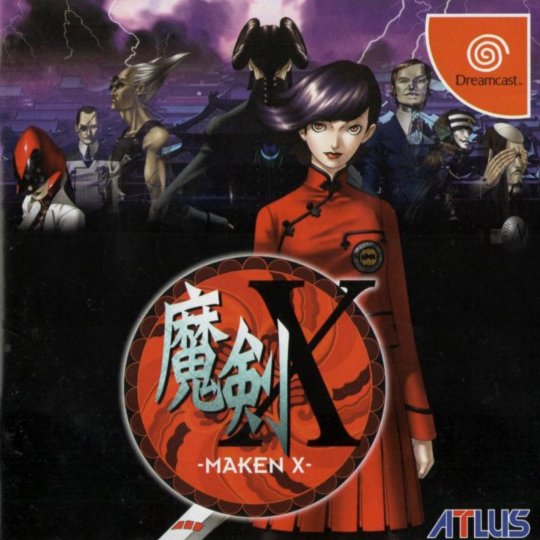


Atlus' futuristic vision of Earth in Maken X includes a most unexpected tour of Europe, with a mandatory stop in Lisbon. Inexplicably, the developers got its geographic location wrong and moved to all the way to the northern Spanish region of Léon. The level, itself, boasts a reasonably accurate depiction of one of the city's oldest quarters, Alfama, and the architectural styles found therein.


Although I could not discern any actual references in the game itself, the Grandia II soundtrack by the veteran composer Noriyuki Iwadare contains two themes whose lyrics are written in Portuguese: A Deus, a double-entendre that can be translated to both farewell and to God; and Canção do Povo, meaning People's Song. Also, the name of the official soundtrack is named Melodia, which translates to Melody as you'd expect. Both themes were performed by guest singer Kaori Kawasumi, who took on the composer's challenge to sing them despite her not knowing the language.
She was coached and assisted by José Álvarez and Motoi Sato from the Portuguese Arts and Culture Center in Japan, whom she thanks in the acknowledgement section. The Grandia II Special Package edition booklet contains a page with two photos of Portugal, one for the Jéronimos Monastery in Lisbon and the other, seemingly, for the Moorish Castle in the nearby town of Sintra.
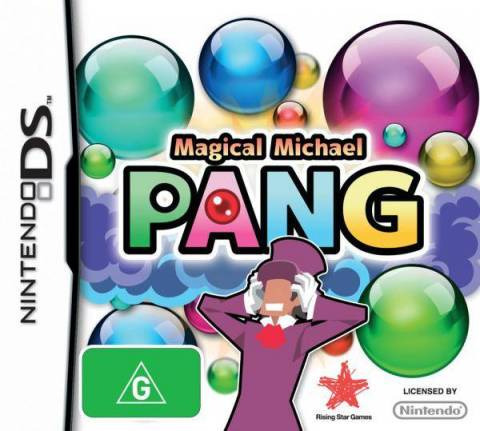
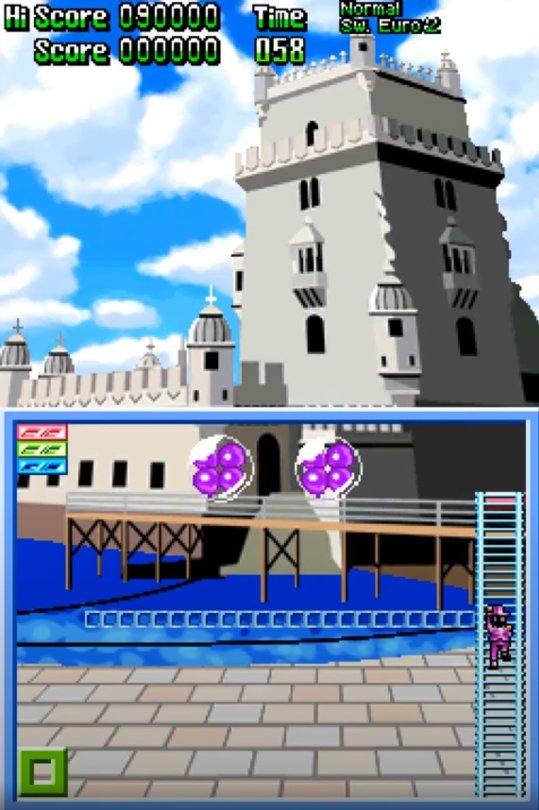
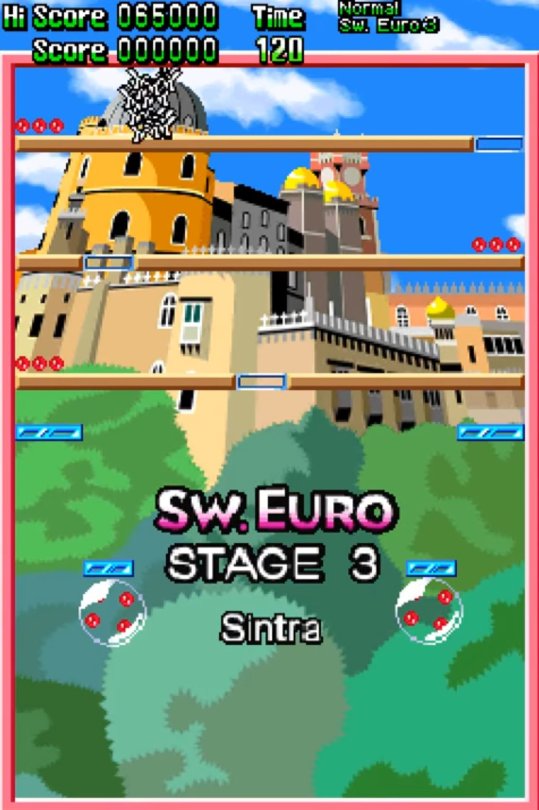
The last Pomping World (a.ka. Buster Bros/Pang) that Mitchell Corporation ever produced before shutting down was the 2010 DS European exclusive Magical Michael. It includes two levels set in Portugal, one in Lisbon by the Belém tower, a nautical landmark, and the other in the Sintra National Palace. Their representation is at once pleasingly stylized and true to life.


This final reference is found in Spike Chunsoft's third installment of their successful visual novel series, Nyūdanganronpa V3 Minna No Koroshiai Shin Gakki. Among the dozens of MonoMono machine items that can be acquired, one is a weathercock styled after a traditional Portuguese folktale hero, the Galo de Barcelos, meaning the rooster of Barcelos, a town in Northern Portugal.
As per the description, this animal became famous through an age-old tale involving a man wrongly sentenced to death who seconds before his execution remarked he was as certain to be innocent as it was certain that a nearby rooster would sing. Because the bird did crow, much to everyone's amazement, he was exonerated. Thus, the black rooster became a symbol for truth.
I would like to thank @diogojira and @DanielOlimac for their assistance in making this article possible.
#Japanese history#Portugal#culture#tradition#japanese videogames#portuguese references in japanese video games#Uncharted waters#the atlas#neo atlas#maken X#pang#magical michael#grandia II#koei#atlus#game arts#mitchell corporation#spike chunsoft#artdink#lisbon#alfama#Noriyuki Iwadare#kaori kawasume#sintra#book of watermarks
51 notes
·
View notes
Text
Our Contestants
1: Maria Leopoldina of Austria, First Empress of Brazil
2 Dona Maria I of Portugal
3: Dona Maria II of Portugal
4: Isabel, Princess Imperial of Brazil
5 Carlota Joaquina de Bourbon
6: João I, Duke of Bragança
7 João IV, King of Portugal
8: Afonso I, Duke of Bragança
9: Fernando I, Duke of Bragança
10: Jaime I, Duke of Bragança
11: Teodósio I, Duke of Bragança
12: Teodósio II, Duke of Bragança
13: Afonso VI of Portugal
14 Pedro II of Portugal
15: João V of Portugal
16: João VI of Portugal
17: Pedro II of Portual
18 Pedro I of Brazil/ IV of Portugal
19: Miguel I of Portugal
20: Pedro V of Portugal
21: Luís I of Portugal
22: Carlos I of Portugal
23: Manuel II of Portugal
24 Dom Pedro II of Brazil
25: Teresa Cristina, Empress of Brazil.
26: Catherine de Bragança, Queen Consort of England, Scotland, and Ireland
27: Infante Dom Manuel, Candidate for the throne of Poland
28: José I of Portugal
29: Carol II of Romania (Carlos II in Portuguese)
30: Ferdinand I of Romania
31: Infantá Antonia de Bragança, Princess Consort of Hohenzollern
32: Amélie of Leuchtenberg
33: Infanta Isabel Maria, Regent of Portugal
34: Mariana Vitória of Spain, Queen Consort of Portugal
35: Maria Francisca of Savoy (Consort to Afonso VI and Pedro II)
36: Maria Pia of Savoy (Queen-Consort to Luís I of Portugal)
7 notes
·
View notes
Note
"well, Brazil. In some twenty or thirty years?" Sorry I'm really stupid and know nothing of history, but who married in whom in Brazil? And Brazil wasn't a colony?
Don't worry, the way they teach story for us is confusing, and if you are brazilian or portuguese I don't think they would teach about this at all.
Short answear: Brazil went from colony to united kingdom to empire to republic in the span of 74 years.
Long answear: Portugal refused to join the continental blockade that Napoleon imposed on England. To escape the invasion of Napoleonic troops, the prince-regent Dom Pedro VI transferred the seat of the court to Brazil, then a colony, and the royal family and the court fled en masse.
The troops were expelled from Portugal by the British just under a year later, but the court remained in Brazil.
At the end of the war, in 1815, Brazil ceased to be a colony when the United Kingdom of Portugal, Brazil and the Algarves was created, so that Dom João could have his autority recognized without having to return to Europe.
Five years later Dom João, now king, returned to Portugal on account of the Liberal Revolution of Porto (I'm not sure what it's called in English); in short, they wanted the royal family to return and for Brazil to become a colony again, which would benefit Portuguese merchants.
The son and heir of Dom João, Dom Pedro*, remained in Brazil and allied with the agrarian elites here, who feared precisely the changes that the Portuguese elite were asking for.
The political scene was tense, divided into two parties, and this culminated in the declaration of independence in 1822, when Brazil became an empire, with Dom Pedro as emperor.
With Dom João's death, Dom Pedro I abdicated and returned to Portugal to reclaim the Portuguese throne, being succeeded in Brazil by his 5 years old son, Dom Pedro II, who took the throne aged 14 after a regency period.
He would have been succeeded by his eldest daughter, Princess Isabel, but the republic was declared in 1889 while he was still alive.
Regarding marriages:
Dom João married the spanish princess Carlota Joaquina de Bourbon.
Dom Pedro I married the archduchess Maria Leopoldina da Áustria (Marie Antoinette's niece!) and Amélia de Leuchtenberg, a franco-bavarian princess.
Dom Pedro II married the princess Teresa Cristina das Duas Sicílias (a kingdom comprising Sicily and Naples).
Princess Isabel married Gaston de Orléans, Count d'Eu, a french prince.
I hope this is not too long or confusing, I tried to get all the necessary info to explain why and how this anomaly happened.
*He was Dom Pedro IV in Portugal and Dom Pedro I in Brazil.
2 notes
·
View notes
Text























Restoration of Independence Day
The Portugal Restoration of Independence Day is a Portuguese holiday on December 1 of every year. Independence Restoration Day or Portugal Independence Day is a national holiday in Portugal that commemorates when the country revolted against Spanish rule and regained its independence after 60 years of Spanish occupation. The war between Portugal and Spain began with the Portuguese revolution and ended with the Treaty of Lisbon.
History of Portugal Restoration of Independence Day
On December 1, 1640, a small group of conspirators stormed the royal palace in Lisbon and deposed the Vicereine of Portugal. Margaret of Savoy tried to calm the Portuguese people during demonstrations in the Terreiro do Paço, at the time, Lisbon’s main square, but her efforts failed. King João IV, the head of Portugal’s senior noble family, accepted the throne on the same day he was offered it. King João IV’s entire reign was dominated by his fight to keep Portugal from being conquered by Spain. On June 12, 1641, Portugal and the Dutch Republic signed a treaty of alliance. It was not respected by either party and had no effect on Brazil or Angola, which were under Dutch occupation at the time.
Shortly after Afonso VI came of age in 1662, Luís de Vasconcelos e Sousa, 3rd Count of Castelo Melhor, befriended the mentally deficient king. He convinced the king that his mother was plotting to steal his throne and exile him from Portugal. Afonso asserted himself as ruler, sending his mother to a convent and appointing Castelo Melhor as his secret notary. This position allowed Castelo Melhor to exercise the functions of the first minister. Because of Afonso’s weakness, Castelo Melhor became the virtual dictator of Portugal.
The Treaty of Lisbon with Spain, signed in 1668, ended 28 years of war. The regent of Spain, Mariana of Austria, acted in the name of her young son Charles II of Spain and, after a series of negotiations between representatives from both countries, finally recognized the legitimacy of the Portuguese monarch. Portugal kept all of its remaining overseas colonies, except Ceuta on the north African coast, which didn’t recognize the Bragança Dynasty during the war.
Portugal Restoration of Independence Day timeline
1640
Attack on the Royal Palace
On December 1, a small group of conspirators storm the royal palace in Lisbon and depose the Vicereine of Portugal.
1641
The Treaty of Alliance is Signed
On June 12, Portugal and the Dutch Republic sign the Treaty of The Hague.
1662
Afonso VI Asserts Himself as a Ruler
After his mother’s regency, Afonso VI asserts himself as the ruler of Portugal.
1668
The Treaty of Lisbon
On February 13, the Treaty of Lisbon is signed by Portugal and Spain.
Portugal Restoration of Independence Day FAQs
How did Portugal maintain its independence?
Britain’s participation in the Peninsular War helped keep Portugal independent; French troops were expelled from the country. The war cost Portugal a town that Spain now governs: Olivença. Rio de Janeiro, Brazil, served as the Portuguese capital.
What is Portugal's largest religion?
Today, Portugal is 81% Roman Catholic, but most Portuguese consider themselves non-practicing. Most Portuguese identify as Catholic for cultural rather than religious reasons.
Do Spain and Portugal like each other?
Spain and Portugal currently have excellent relations and cooperate in the fight against forest fires and drug trafficking.
How to Observe Portugal Restoration of Independence Day
Take part in a parade or other eventsIf you're visiting Lisbon, there are plenty of parades taking place throughout the city. You can also find smaller events happening at local schools and churches. Take part and join the crowd in celebrating this holiday.
Visit the Military Museum of LisbonThe Military Museum of Lisbon is located on Praça do Comércio. The museum has since been preserved as a tribute to all those who fought for independence from Spain, and it contains equipment used during the war. Give it a visit and learn more about Portugal's rich history.
Enjoy the beautiful architectureLisbon has some of the most beautiful buildings that you will ever see in your life! There are so many incredible buildings, from churches to palaces and castles to houses, that it would amaze you.
5 Impressive Facts About Portugal
The oldest nation in Europe: Portugal's borders were established in 1139 A.D., making it Europe's oldest nation.
It is always sunny in the Algarve: The Algarve coast has a Mediterranean climate, even though it is located on the Atlantic Ocean, where there are about 3,000 hours of sunshine a year, making it one of the sunniest regions in Europe.
The land of great explorers: Ferdinand Magellan and Diogo Silves are among many great Portuguese explorers who discovered new lands.
The Portuguese language is widespread: This beautiful language is spoken by more than 274 million people worldwide,
The Portuguese descend from Celtic people: The Portuguese heritage is mainly derived from the pre-Celts, proto-Celts, and Celts.
Why Portugal Restoration of Independence Day is Important
It is a significant turning point for Portugal: This day celebrates Portugal's independence and the Portuguese national identity. It symbolizes the first steps taken toward modernity and progressiveness.
It celebrates Portuguese history: The restoration of independence was a critical historical event that led to a significant shift in Portuguese politics and culture. Thus, this day marks this huge transition and recognizes its significance.
It helps strengthen the Portuguese nationality: Commemorating the Restoration of Independence in Portugal helped to strengthen national unity. This gives people a common goal to strive for and unite around.
Source
#Restoration of Independence Day#Restauração da Independência#Praça do Comércio#Lisbon#Lisboa#Albufeira#Atlantic Ocean#Camões Monument by Victor Bastos#D. Maria II National Theatre#Rossio#Ourique#Belém Tower#São Jorge Castle#anniversary#Portuguese history#summer 2021#tourist attraction#cityscape#architecture#landscape#seascape#Southern Europe#original photography#1 December 1640#travel#vacation#landmark
0 notes
Text
Events 12.1 (before 1950)
800 – A council is convened in the Vatican, at which Charlemagne is to judge the accusations against Pope Leo III. 1420 – Henry V of England enters Paris alongside his father-in-law King Charles VI of France. 1577 – Courtiers Christopher Hatton and Thomas Heneage are knighted by Queen Elizabeth I of England. 1640 – End of the Iberian Union: Portugal acclaims as King João IV of Portugal, ending 59 years of personal union of the crowns of Portugal and Spain and the end of the rule of the Philippine Dynasty. 1662 – Diarist John Evelyn records skating on the frozen lake in St James's Park, London, watched by Charles II and Queen Catherine. 1768 – The former slave ship Fredensborg sinks off Tromøya in Norway. 1821 – José Núñez de Cáceres wins the independence of the Dominican Republic from Spain and names the new territory the Republic of Spanish Haiti. 1822 – Pedro I is crowned Emperor of Brazil. 1824 – United States presidential election: Since no candidate received a majority of the total electoral college votes in the election, the United States House of Representatives is given the task of deciding the winner in accordance with the Twelfth Amendment to the United States Constitution. 1828 – Argentine general Juan Lavalle makes a coup against governor Manuel Dorrego, beginning the Decembrist revolution. 1834 – Slavery is abolished in the Cape Colony in accordance with the Slavery Abolition Act 1833. 1862 – American Civil War: In his second State of the Union Address, President Abraham Lincoln reaffirms the necessity of ending slavery as ordered ten weeks earlier in the Emancipation Proclamation. 1865 – Shaw University, the first historically black university in the southern United States, is founded in Raleigh, North Carolina. 1878 – President Rutherford B. Hayes gets the first telephone installed in the White House. 1900 – Nicaragua sells canal rights to U.S. for $5 million. The canal agreement fails in March 1901. Great Britain rejects amended treaty. 1913 – The Buenos Aires Metro, the first underground railway system in the Southern Hemisphere and in Latin America, begins operation. 1913 – Crete, having obtained self rule from Turkey after the First Balkan War, is annexed by Greece. 1918 – Transylvania unites with Romania, following the incorporation of Bessarabia (March 27) and Bukovina (November 28) and thus concluding the Great Union. 1918 – Iceland becomes a sovereign state, yet remains a part of the Danish kingdom. 1918 – The Kingdom of Serbs, Croats and Slovenes (later known as the Kingdom of Yugoslavia) is proclaimed. 1919 – Lady Astor becomes the first female Member of Parliament (MP) to take her seat in the House of Commons of the United Kingdom. (She had been elected to that position on November 28.) 1924 – The National Hockey League's first United States–based franchise, the Boston Bruins, plays their first game in league play at home, at the still-extant Boston Arena indoor hockey facility. 1934 – Sergei Kirov is assassinated, paving way for the repressive Great Purge, and Vinnytsia massacre by General Secretary of the Communist Party of the Soviet Union, Joseph Stalin. 1939 – World War II: A day after the beginning of the Winter War in Finland, the Cajander III Cabinet resigns and is replaced by the Ryti I Cabinet, while the Finnish Parliament move from Helsinki to Kauhajoki to escape the Soviet airstrikes. 1939 – The Soviet Union establishes the Finnish Democratic Republic puppet state in Terijoki. 1941 – World War II: Emperor Hirohito of Japan gives his tacit approval to the decision of the imperial council to initiate war against the United States. 1941 – World War II: Fiorello La Guardia, Mayor of New York City and Director of the Office of Civilian Defense, signs Administrative Order 9, creating the Civil Air Patrol.
0 notes
Photo
From what I can make out back row l-r Dom Fernando king consort of D Maria II king by right of D. Pedro V and D Luis King of Portugal, D. Pedro V is wearing the military hat and the splendid tache I had never seen. I am very diplomatic about about this, so they are all my grandfathers. Prince Leopold is stitting down, Prince Charles, possibly at the end. Dom João and Dom Augusto in the top hats, I think in that order. I think the Infanta Dona Antonia is the great-grandmother of D. Augusta Victoria, Queen Consort of D. Manuel II, which is why we are cousins.

Members of the Portugese Royal Family : Infanta Donna Antonia her husband Prince Leopold of Hohenzollern, King Pedro V of Portugal, Dom Louis, Duke of Oporto, Dom Joao Prince of Portugal, Dom Augusto, Prince Charles of Hohenzollern, Dom Ferdinando, 1861.
91 notes
·
View notes
Text
São Jorge's Castle
Monuments
São Jorge Castle is one of Lisbon's most emblematic monuments, located on the city's highest hill.
The oldest known fortification at the site dates back to the 17th century. II BC, although traces found here date back to the 17th century. VI BC Archeology has also made it possible to discover traces of Phoenicians, Greeks, Carthaginians, Romans and Muslims, proving constant human occupation since ancient times.
The castle itself was founded in the 10th and 11th centuries, when Lisbon was an important Muslim port city. In 1147, the first king of Portugal, D. Afonso Henriques, conquered the castle and the city from the Moors. Between the century. XIII and the century. XVI had its most important period. In the century. XVI, it was in the castle that King D. Manuel I received Vasco da Gama after his sea voyage to India and that the first Portuguese theater play, written by Gil Vicente, was performed, on the occasion of the birth of King D. João III.
Declared a National Monument in 1910, it underwent major restoration work during the 19th century. XX, which gave it its current appearance. It is one of the most important places in the city and a leisure space very popular with the population of the surrounding neighborhoods. It can be said that it has the best view of the city and the Tagus River.
Inside, the museum center stands out, where you can see the history of Lisbon, and the Ulisses Tower. The city's legendary founder gives its name to the castle's ancient Torre do Tombo where a periscope allows you to observe the city in 360º in real time.
instagram
0 notes
Text

#Rothschild financed slavery
#Portuguese started the #slave trade
where do you think these 3 Kings are in life’s 🤴🏿 prison #Sheol being #tortured by #demons for #persecuting his people Israel 👑
the 3 Kings who #expelled my family 👑 #Inquisition
João II of Portugal King of Portugal 🇵🇹
Manuel I King of Portugal 🇵🇹
Ferdinand II of Aragon King of Spain 🇪🇸
0 notes
Text
Portuguese Coins Sale on Online

Introduction
Portuguese coins have a rich history that spans several centuries. They reflect the country's cultural heritage, economic development, and political events. Portuguese coins have evolved over time, incorporating various designs and motifs that represent the nation's identity. The first Portuguese coins were introduced during the reign of Afonso Henriques, the first King of Portugal, in the 12th century. These early coins were influenced by Roman and Moorish currencies and featured religious symbols, including crosses and crescents. During the 20th century, Portugal transitioned from a monarchy to a republic, and its coins reflected these changes. The escudo became the national currency, and various denominations were issued with images of historical figures, national landmarks, and important events.
The history of Portuguese coins
dates back to ancient times, with the region known as Portugal having been inhabited for thousands of years. However, for the purposes of this response, I will focus on the history of Portuguese coins from the establishment of the Kingdom of Portugal in the 12th century to the present day.
Afonso Henriques (1139-1185):
The first Portuguese coins were minted during the reign of Afonso Henriques, the first King of Portugal. These coins were mainly small silver coins known as "morabitinos" and were modeled after the Muslim dinars and Christian pennies of the time.
Dinheiro and Ceitil (12th-15th centuries):
During the medieval period, Portugal used the Dinheiro as its main unit of currency. Dinheiros were small copper coins and were the most common denomination. Another coin called the Ceitil, made of silver, was also used. These coins went through various design changes over the centuries.
Real (15th century):
In the 15th century, King João II introduced a new coin called the Real, which was made of gold. The Real became the official currency of Portugal and remained in circulation for several centuries. It was highly regarded and respected as a stable currency.
Cruzado and Escudo (16th-20th centuries):
In the 16th century, the Cruzado, a silver coin, was introduced as the new currency. It had a cross on one side and a Portuguese shield on the other. The Cruzado was later replaced by the Escudo in the early 20th century, which became the official currency of Portugal until the introduction of the Euro.
Euro (2002-present):
Portugal adopted the Euro as its official currency on January 1, 2002, along with several other European Union member states. Since then, Portugal has used Euro coins and banknotes, which are standardized across the eurozone.
It's important to note that this is just a brief overview of the history of Portuguese coins. Over the centuries, Portugal minted numerous coin denominations, each with its own unique designs and historical significance. Coin collectors and numismatists can delve deeper into the subject to explore the wide variety of Portuguese coins issued throughout history.
Portuguese coins offer several advantages, both practical and historical. Here are some advantages of Portuguese coins:
Durability: Portuguese coins are typically made from high-quality materials like copper, bronze, and nickel-plated steel, which makes them durable and long-lasting. They can withstand wear and tear, ensuring that they remain in circulation for extended periods.
Design and Aesthetics: Portuguese coins often feature intricate and visually appealing designs. They showcase important elements of Portuguese culture, history, and national symbols, making them attractive to collectors and enthusiasts of numismatics (the study and collection of coins).
Historical Significance: Portuguese coins carry a rich historical legacy. Portugal has a long and storied history, and its coins reflect different periods and rulers throughout the centuries. Collecting Portuguese coins can provide a fascinating insight into the country's past and serve as a tangible connection to historical events.
Collectible Value: Due to their historical significance and aesthetic appeal, Portuguese coins can be sought after by collectors. Rare or limited-edition coins can have significant collectible value, making them potentially lucrative investments.
Cultural Representation: Portuguese coins often depict important cultural and historical figures, landmarks, or events, serving as symbols of national pride and identity. They contribute to preserving and promoting Portuguese heritage both domestically and internationally.
Economic Stability: The use of national currency, such as Portuguese coins, promotes economic stability within a country. They facilitate daily transactions, are easily recognizable, and foster trust in the monetary system.
Accessibility: Portuguese coins come in different denominations, catering to various transactional needs. Having a range of coins available makes it convenient for individuals to pay exact amounts or make small purchases without relying solely on banknotes.
Souvenir and Gift Options: Portuguese coins can make unique and meaningful souvenirs or gifts. They offer a tangible memento of a trip to Portugal or a connection to Portuguese heritage, making them a thoughtful choice for collectors, travelers, or individuals with an interest in history and culture.
It's worth noting that while Portuguese coins have these advantages, the broader trend in many countries is shifting towards digital and cashless transactions. Nonetheless, coins remain an essential part of the monetary system and possess intrinsic value beyond their face value.
Conclusion
the history of Portuguese coins spans many centuries, reflecting the evolution of the Kingdom of Portugal and its economic development. From the early silver and copper coins minted during the medieval period to the introduction of the Real, Cruzado, Escudo, and ultimately the adoption of the Euro, Portuguese coins have been an integral part of the country's monetary system.
#World Wide Coins#world coins for sale in india#coins of queen elizabeth#foreign coins for sale in india#coin collectors in india#coin collections for sale in india
0 notes
Note
Actually I'm going to do that right now since todya I'll be buried in work and later on I'll just say "don't have time".
There's two things that must be understood when we talk about Jewish history in Portugal:
Number one: Portuguese Jews enjoyed a relative freedom, especially compared to Eastern Europe, throughout the middle ages, right until more or less 1492. This does not mean there weren't oppressive instruments put into place, or that antisemitism did not exist. It did. Jews lived in ghettos, called "judiarias", and they were forced to be back inside by sundown. They had one way in and one way out. They had, occasionally, to wear something in their clothing to let others know they were jews. They could not mix with Christians. They were barred from certain jobs (NOT A LOT! there were some, and I genuinely don't remember which, but as you'll see, not a lot).
But they were also protected by the king. Of course, when you really look at it, it all comes down to possession and to economy. The jewish population of Portugal was so significant they pretty much held our economy together (this will help you understand the 1496 expulsion). The kings of portugal often referred to the jewsih population as "my jews" and conceded them protection. Every king had a jewish doctor/surgeon, and many other Jewish families served the royal family. By the late 1300s, early 1400s, the richest families were the Guedelhas and the Negros--both jewish. The Palanço were so rich, they owned half of Sintra.
There's documentation that attest to jewish people's professions: they were artisans, and cobblers, and surgeons and doctors. The permeated jobs related to knowledge and literacy -- like astronomy and astrology and medicine -- because they were considerably far more educated than Christians. Queen Philippa of Lancaster had her own astrologer. King Duarte also had his own astrologuer, and often contacted him before heading off to battle.
Then there's the question that's so central to antisemitism: why were so many jews in banking? The explanation given is often that they were barred from literally everything, but that's not 100% true in Portugal. The reason is just because usury was a sin in Christianity, so charging a loan back with interest was something Christians couldn't do, but Jews could.
But not even half the population is in banking. Over time, these jewish families will create a massive network of connections across the globe. They will accrue wealth and connections in sugar cane trading, spices, silk... And these span from north africa, to the newly discovered and colonised Madeira islands, and the east. They have authority in many ports, they have the ability to move around so easily, John II will even hire one jewish spy to go to Africa and search for Prestes João (another can of worms).
And then, number 2: there's a common misconception that the Inquisition is based on witch hunts. But there isn't a single account of a single witch having been found in Portugal. We often couple it with the spanish inquisition and to be fair, I am not going to get into the Spanish Inquisition as I don't know shit about it, but in Portugal, the inquisition is 100% founded on antisemitism.
As I said, Jews lived with a relative degree of freedom when compared to other parts of Europe, and this is actually going to become an issue when the diaspora spreads through other countries, and these Sephardic Jews struggle to fit in with other communities because they just don't have the same struggle. To them, and especially the wealthy families, they lived a good life until, out of nowhere, Manuel I ruined everything. So there's even, to quote Esther Mucznick, "a feeling of superiority" when they become refugees and try to settle elsewhere. There's a story fo one who will try everything in his power to fit in with the community in Amsterdam (I believe Hasidic but I could be wrong) but in the end takes his own life because he just cannot fit in.
So we then get to 1492, which is the year Granada falls in Spain and Isabella the Catholic kicks out all Jews. In spain, jewish persecution had gotten worse since around 1391 I believe, and Jews had gradually lost their rights. That, as we saw, was not the case in Portugal.
Many of those jews run away to Portugal. John II, king at the time, welcomes the wealthy and does grant these refugees the ability to stay in the country, but gives them 8 months to sort out their problems, and after 8 months they must leave and pay an exorbitant amount of money per person in the family in order to leave. 8 cruzados, the price, was completely unachievable. The result is that, eight months later, the kings keeps his word. He kidnaps the children of these families and sends them to work in plantations in São Tomé, called Meninos de São Tomé.
The wealthy, however, manage to stay. This was John II's plan: make good use of the rich the spanish are kicking out to benefit his kingdom, and for that, he puts in place a series of laws that limit Jewish freedom exceptionally, including not allowing them to leave.
Manuel I rises to the throne right after John II dies in 1495, and the first thing Manuel I does is revoke all these discriminatory laws John II passed.
And this is what is so blogging about Manuel I.
I think that, to understand his actions, one has to understand the following:
He rose to the throne without having any blood ties to his predecessor, and was "elected" because there was no heir. However, he does have ties to the royal family.
He gets to the throne right as the Discoveries are about to generate a lot of profit. Yes, Vasco da Gama finds the sea route to India while he's on the throne, and Brazil is "found" 5 years after he's gotten there, but these are the result of long investigations, if you will, that Manuel did nothing about. He literally benefits from doing nothing. This is important
You put point one and two together, you have a king who wants to legitimate himself and especially be perceived as a Christian Emperor. One thing I tell people in all of my tours is this: to undertsand Portuguese colonialism, it must be seen through the eyes of Christianity. Christianity is a way to homogenise the Empire, but for Manuel I, it is a way of centralising power.
And that's his end goal: the centralisation of power around himself.
So, 1495 he writes to Isabella the Catholic and says he wants to marry her daughter. Isabella, the daughter in question, says she will only do so if he cleanses the country of heretics.
She means jews and moors (muslims).
Manuel, without much thought, does exaclty that. And to understand why he would bend the knee like a whimp to Spain, it must be understood that, within the scope of being crowned not just king, bu Emperor of Christianity, as he wished, Spain was a part of this. He wished to unite the Peninsula under this name. In fact, when he signes the marriage agreement with Isabella, he is sworn heir to the Spanish crown.
That's why hegemonising the country as a purely and fully Christian country, or empire, was so important.
Except, as we've seen, jews in Portugal aren't just any type of population. By 1496, they've enbiggened their riches and their trading businesses is even better. So this is the crucial point I hinted at above: if Manuel kicks them out, the ecnomy will collapse. DOn't listen to whatever some right wing fucker says about this, because the truth is literally every historian agrees on this: Jewish people held such power in Portugal's economy, they could have collapsed this all to shit. And many, many historians agree that what followed is the first of a series of steps that will lead to the collapse of the Portugese Empire.
So, now I'm going to circle back to your question: how is it that the jewish population in Lisbon is so small? What led to this?
It was Manuel's politics.
1496, the order of expulsion is issued in December. Manuel gives Jews until October next year. But he had no intention, never had, of letting them leave. His plan is not to kick anyone out, but to assimilate.
Thousands of people come to Lisbon, the only port where you're allowed to board a ship and leave. But when they get there, there are no ships. Instead, friars, priests and bishops perform mass baptism.
Now you might wonder, if people don't convert honestly -- and in Christianity, forced conversion is actually forbidden, which is why this episode and what follows will be controversial even to the vatican -- what's the point? The point was that, to the Portuguese Christian Church, they were now Christians. So any "jewish act" could be condemned. That's the goal.
Then, Manuel I kidnaps the children of all these families up to 14 years old and entrusts them to Christian families to be raised Christian. No one knows what happens to them. To this day. Historians have wondered and have come with theories, but they vanished. Remember, mandatory church records of baptisms, weddings and death don't become a thing until 1570 I believe, so there's no record of what happened to these children.
He then forbids every one of these "newly converted" families from leaving the country.
His politics are 100% of assimilation, and he wanted all of these newly convert, now called new christians (this is an important denomination) to be fully integrated into society. Which is he passes a bunch of laws protecting them. One of them states that New Christian Families CANNOT be persecuted or accused of mispracticing christianity (which the one law the Marquis of Pombal will use succesfully to banish the disctinction between new and old christians).
But from the Christian people's persepctive, this actually aggravates antisemitic feeling. Because the fact was, until then, Jewish families lived in their own judiarias, and they had their own separate practices. And like I said, antisemitism was very much present despite king's protection. John I actually stopped a pogrom from happening and punished everyone involved by sentencing them to death, for example. There are several accounts of christians' complaints regarding Jews holding the monopoly of whatever business they own.
But now, they're protected.
Which explains the Lisbon Pogrom of 1506.
It allegedly happened because a light fell on a cross of Christ inside the Chruch of St Dominick in Lisbon, and while everyone chanted it was a miracle, one New Christian man said "If God wnated to perform a miracle, he would not light up a piece fo stick". This was seen as such heresy he was beaten to death.
One thing Manuel failed to acknowledge was that the small clerical population -- friars -- was immense in Lisbon, and they are the main characters of antisemitism in the country. They are the ones who, since they're on the side of the people and lower folk themselves, will instigate not just this Pogrom, but attempts at others in the past. And its two friars from this church that will rile up the population, leading to a massacre that spans for 3 days, of somewhere between 2000 to 4000 victims.
The very next year, Manuel changes the law and allows New Christians to leave the country. It's the first big exodus of jewish families, people like Abraham Zacuto, a spanish-born jew who wrote the most important book in navigation the portuguese will use throughout the century, Almanach Perpetuum.
And then comes the Inquisition.
Manuel is the first to write the Pope to requets the inquistion in 1515, but is denied. His son, John III, who is arguably and in my opinion the most useless fucking king every produced, will raise such a fucking fight with the Vatican he at one point, as well as his counsellors, consider rejecting the Vatican as Henry VIII did (he's actually advised to do this).
He wants the inquisition, but by now, the Spanish Inquisition has earned a terrible name. It's actually considered savage by the Vatican, and the iberian peninsula, for how we treat new christians, is seen as a barbaric land. I'm not exaggerating and can give you the bibliography on this shit. John III wants an Inquisiton that: 1) has full control of every process of its won court, 2) has power above any Bishop, 3) allows investigation to happen without what we call due process, so via anonymous accusations and without solid proof of anything, 4) and finally, he wants an Inquisition that is allowed to take the properties of new christians and accumulate wealth for themselves, which is exactly what the Vatican refuses. This is the inquisition he wants, and he will fight for two decades tooth and nail to obtain it.
As we know, he will do it, to the detriment of the country. By now, most members of the royal family, especially male, are high positioned clerics, and he wants to accrue that wealth for himself. The Vatican, at one point, approves of an Inquisiton but to make sure John III follows what has been agreed, they send out clerics to perform the duty. This fucking guy comes up with situations, problems and such, that basically will ostracise these men. He literally pushes them out, which is what happens.
THe inquisition is officially brought into the country in 1530; 1536, it arrives in Lisbon. But its only in the 40s that the Inquisition John III wants is allowed, since the Vatican just fucking gives up.
In the mean time, these small friars I mentioned above have been performing their duty: they have riled the people to participate in a false inquisition, and have been burning people alive and hunting new christians.
That's how we get the inquisition, in its full brutality. Now, anonymous accusations can be made. The accused is not told of what his accusation is. THe accused faces 3 interrogations without knowing. The accused must also dennounce others like him, including their names and addresses. The accused is then subjected to torture. It's lose-lose situation: if you confess right away, the inquisition is perfectly allowed to not believe your confession, and thus torture you; if you deny the crime you're not aware of, then they will torture you still. While incarcerated, a guard must watch you at every hour, to spot any "judaism" you might show, and if you are released, the Inquisition has since confiscated all your belongings, and you are socially ostracised and with nothing, as well as your entire family.
The reason for John III's stubborn insistence was simple: he claimed, time and again, that judaism was a real, perverted threat. The Vatican insisted, quite surprisignly actually, that it is expected for new Christians to not fully adhere to all Christian practices, and to still practice old habits, because they're slowly adapting to Christianity. John III refuses this.
Our witch hunts are 100% focused on finding cryptojews and punishing them.
I remember reading a record of an accusation which consisted of: the person in question washed the clothes of the deceased and dressed them in a specific (forgot which) fabric. Which does relate to Jewish habits, but this is the extent of these accusations, which will prevail through centuries: minor habits Christians are suspicious of.
To this day, there are sayings born of this horrific moment. "He's thinking of the heifer's death" is something you say when someone looks sad. This was said of cryptojews who were caught by the inquistion. THe heifer refers to vellum, the type of "paper" used in the Torah. "Watching the ships pass" is something you say to someone who is left stood up. It refers to the people who awaited ships in 1497 that never came, and who would go to Santa Catarina hill to look at the river. And to this day, people still say "fazer judiarias" which translates to something like "performing jewish things" to mean he's misbehaving.
So, the answer to the question "what happened to the jews of Portugal" is not they were expelled. It's: they were assimilated through brutal force, torture and persecution. Yes, many left, but even more were lost to history. All those children that were taken to Christian families, and all the New Christians that were forced to convert. The inquistion made sure "judaism" was enough of a bad word that, whoever was left, was terrified into Christianity.
There are A LOT that survived through time, and let me just finish this off by leaving you with the incredible story of the Belmonte Jewish Community, which survived until 1917.
Ana I don't get something. In some government sources (not Portuguese tho, so maybe that's why) it says there's only 600 Jewish people in Portugal?? That has to be fake right? Because another sources states there are at least 30,000 Sephardic Jews in Portugal.
It's definitely closer to 600.
I know it was 600 around 2015, but the number has since risen to 1500 in recent years, according to the bbc.
The link above is in portuguese but it does state what I believe is the source of confusion.
There are 1500 practicing jews in portugal. Since around I believe 2015, there has been a law, same as Spain, that in order to seek forgiveness for the repression and persecution suffered, anyone who can prove sephardic portuguese ancestry can get portuguese citizenship.
So far around 30.000 people have applied for that. That's where I think the number comes from.
I'm typing this on my phone and was just about to get in the shower but there's actually very good and obvious reasons (or, they will become obvious) to why the jewish population of portugal is so small. If you want to understand more just let me know
109 notes
·
View notes
Text
500$ with the face of King João II of Portugal

Entry in circulation: 04-11-1966 Withdrawal from circulation: 09-01-1988
3 notes
·
View notes
Text
Introduction
Do you have opinions on the Serene House of Bragança (or Braganza) Do you wish to join the Brigantine Dynasty as it streches from East Timor to Brazil. Do you wish to eat Caldo Verde in a hot day in Portugal. Do you enjoy seeing drama, plotting, consorts more interesting than their Bragança husbands and the glory that is coming to Brazil? If so this defunct house of rulers that has had claimants and candidates to the thrones of Greece and Poland, as well as Monarchs of Portugal and royal consorts that have provided Monarchs such as Ferdinand of Romania? Dilettantes including the Infante Manuel de Bragança? and of course the Glorious Kings of Portugal and the Emperors of Brazil? If so, come to Brazil Join the tournament to discover the best Bragança!
Listen we may not be as dramatic as the Habsburgs or the Bourbons, but in terms of drama, we are the little house that could (so much drama (the War of the Brothers, the scheming of Carlota Joaquina, João V and his strong love of the catholic church)
Rules:
Who will be included in your lists? Much like notable brackets of Central Europe, we will include unconventional figures who may technically be considered members of other dynasties including *sighs*...at least a few Hohenzollerns (But unlike the @best-hohenzollern-ruler bracket, these will be ROMANIAN HOHENZOLLERNS; which is better).
We will also include the consorts from other royal families whose ambitions, intellect, and force of will may have outshone their admittedly mediocre Bragança spouses (Carlota Joaquina of the Bourbons is fascinating as is Maria Leopoldina of Austria)
Is propaganda encouraged?
Absolutely, as Lilia Schwarcz shows for Pedro II of Brazil, propaganda and pageantry are essential for the construction of the Bragança dynasty and monarchy! As such, It is also essential for this bracket!
Why is everyone a Pedro or João?
Hey, those are perfectly good names....but we also have two Marias who reigned in their own right (Actually, a lot more Marias in this bracket!) We also have some Afonsos
What regnal numbers will you be using?
Honestly, we will be using the Portuguese regnal numbers up until Pedro II of Brazil, who will have emperor in his title to distinguish him (Pedro I of Brazil/ IV of Portugal will have both)/ We will also include a few dukes.
Which language will you be using for the names?
Portuguese....do you really want to deal with a bunch of Johns and Peters?
How would you like it if, say a Habsburg Bracket, called Franz Joseph
Francisco José? It would be weird.
What is your relation to @best-hohenzollern-ruler, @best-habsburg-monarch, and the @best-bourbon-monarch?
Much like the Duke João of Braganza ( the future King João IV of Portugal) we bravely broke off from the @best-habsburg-monarch's bracket to form our own path! However, as is our want, we deeply appreciate the Habsburgs, the Bourbons, and the Hohenzollerns. Thus, we have maintained our propensity to intermarry into each of these families and their membership has joined us as well. So @best-hohenzollern-ruler @best-bourbon-monarch and @best-habsburg-monarch, friends? Also, @rulers-of-poland-tournament, Infante Manuel de Bragança really thinks y'all are swell!
10 notes
·
View notes
Photo


Luise Heyer as Maria Leopoldina of Austria, the Empress Consort of Brazil, Queen Consort of Portugal and Archduchess of Austria
Dona Maria Leopoldina of Austria (22 January 1797 – 11 December 1826) was born Caroline Josepha Leopoldine Franziska Ferdinanda of Habsburg-Lorraine in Vienna, Austria, Holy Roman Empire. She was the daughter of Holy Roman Emperor Franz II and Empress Maria Theresa of Naples and Sicily. In 1817 the Archduchess married Prince Dom Pedro of Braganza (12 October 1798 – 24 September 1834), heir to Portugal, later the Emperor Dom Pedro I of Brazil and King Dom Pedro IV of Portugal. The couple had 7 children: Queen Maria II of Portugal, Miguel, Prince of Beira, João Carlos, Prince of Beira, Princess Januária of Brazil, Princess Paula of Brazil, Princess Francisca of Brazil and Emperor Dom Pedro II of Brazil. On September 2, 1822 while she was the Acting Princess Regent of the Kingdom of Brazil in the absence of her husband Maria Leopoldina signed the Decree of Independence, declaring Brazil separate from Portugal. She died at age 29 in 1826 after a miscarriage. As Acting Regent Maria Leopoldina was the first woman to govern an independent Brazil, the first empress consort of the country, the first empress of the Americas and the first woman to govern an independent American country.
Victoria Guerra as Amélia of Leuchtenberg, the Empress Consort of Brazil and Duchess of Braganza
Dona Amélia of Leuchtenberg (31 July 1812 – 26 January 1873) was born Amélie Auguste Eugénie Napoléonne de Leuchtenberg in Milan, Kingdom of Italy. She was the daughter of Eugène de Beauharnais, Duke of Leuchtenberg and Princess Augusta of Bavaria, Duchess of Leuchtenberg. She was the second wife of Emperor Dom Pedro I of Brazil after their marriage in 1829 and they had one child, the Princess Maria Amélia of Brazil. After Dom Pedro I abdicated the Brazilian crown, Amélia accompanied her husband back to Europe. They held the titles of Duke and Duchess of Braganza until Pedro’s dead in 1834. Amélia died in Lisbon at the age of 60 in 1873.
A VIAGEM DE PEDRO | PEDRO, BETWEEN THE DEVIL AND THE DEEP BLUE SEA (2021). Dir. Laís Bodanzky
#a viagem de pedro#perioddramaedit#filmedit#movieedit#weloveperioddrama#worldcinemaedit#perioddramasource#onlyperioddramas#historicwomendaily#periodedits#braziliansource#cinematv#cinemapix#fyeahmovies#motionpicturesource#filmtv#filmtvdaily#userperioddrama#femaledaily#femalecharacters#flawlessbeautyqueens#historyedit#women in history#period drama#pedro between the devil and the deep blue sea#brazilian cinema#brazilian movies#mine#mine: edit#brazilian stuff
74 notes
·
View notes
Photo

Day 13: Catherine of Braganza!
Catherine of Braganza was a Portuguese princess, daughter of João the Restorer. Her father had warred with Spain to reestablish Portugal as an independent kingdom, and he sought a renewal of Portugal’s centuries-old alliance with England; Catherine was married to Charles II, the recently restored Stuart king.
Catherine had grown up sheltered in a convent, and the licentious English court was a culture shock to her. Charles was gallant and attentive, but he also expected her to take his favorite mistress as a lady-in-waiting. Nevertheless, Catherine came to enjoy life in in England; she discovered a love of dancing and was an enthusiastic participant in Charles’ masked balls, helping to set a trend for ankle-length, easier-to-move-in skirts. Perhaps her most enduring English legacy was to popularize her favorite beverage, tea.
Despite this, Catherine, childless and Catholic, was never a popular queen. Charles stood by her, politically and personally, but after his death her position in the country was shaky. In 1692, after the Glorious Revolution, she returned to Portugal. Her brother, Pedro II, welcomed her back to court, where she quickly developed a strong bond with her nephew, the future João IV. After his mother’s death, she took charge of his education. Catherine twice served as regent of Portugal when Pedro was absent. She died in 1705; João, the nephew she had helped raise, would become one of Portugal’s most influential monarchs.
#catherine of braganza#history#portuguese history#british history#awesome ladies of history#october 2022#my art#the house of stuart#pen and ink
38 notes
·
View notes
Text






















Restoration of Independence Day
The Portugal Restoration of Independence Day is a Portuguese holiday on December 1 of every year. Independence Restoration Day or Portugal Independence Day is a national holiday in Portugal that commemorates when the country revolted against Spanish rule and regained its independence after 60 years of Spanish occupation. The war between Portugal and Spain began with the Portuguese revolution and ended with the Treaty of Lisbon.
History of Portugal Restoration of Independence Day
On December 1, 1640, a small group of conspirators stormed the royal palace in Lisbon and deposed the Vicereine of Portugal. Margaret of Savoy tried to calm the Portuguese people during demonstrations in the Terreiro do Paço, at the time, Lisbon’s main square, but her efforts failed. King Jo��o IV, the head of Portugal’s senior noble family, accepted the throne on the same day he was offered it. King João IV’s entire reign was dominated by his fight to keep Portugal from being conquered by Spain. On June 12, 1641, Portugal and the Dutch Republic signed a treaty of alliance. It was not respected by either party and had no effect on Brazil or Angola, which were under Dutch occupation at the time.
Shortly after Afonso VI came of age in 1662, Luís de Vasconcelos e Sousa, 3rd Count of Castelo Melhor, befriended the mentally deficient king. He convinced the king that his mother was plotting to steal his throne and exile him from Portugal. Afonso asserted himself as ruler, sending his mother to a convent and appointing Castelo Melhor as his secret notary. This position allowed Castelo Melhor to exercise the functions of the first minister. Because of Afonso’s weakness, Castelo Melhor became the virtual dictator of Portugal.
The Treaty of Lisbon with Spain, signed in 1668, ended 28 years of war. The regent of Spain, Mariana of Austria, acted in the name of her young son Charles II of Spain and, after a series of negotiations between representatives from both countries, finally recognized the legitimacy of the Portuguese monarch. Portugal kept all of its remaining overseas colonies, except Ceuta on the north African coast, which didn’t recognize the Bragança Dynasty during the war.
Portugal Restoration of Independence Day timeline
1640
Attack on the Royal Palace
On December 1, a small group of conspirators storm the royal palace in Lisbon and depose the Vicereine of Portugal.
1641
The Treaty of Alliance is Signed
On June 12, Portugal and the Dutch Republic sign the Treaty of The Hague.
1662
Afonso VI Asserts Himself as a Ruler
After his mother’s regency, Afonso VI asserts himself as the ruler of Portugal.
1668
The Treaty of Lisbon
On February 13, the Treaty of Lisbon is signed by Portugal and Spain.
Portugal Restoration of Independence Day FAQs
How did Portugal maintain its independence?
Britain’s participation in the Peninsular War helped keep Portugal independent; French troops were expelled from the country. The war cost Portugal a town that Spain now governs: Olivença. Rio de Janeiro, Brazil, served as the Portuguese capital.
What is Portugal's largest religion?
Today, Portugal is 81% Roman Catholic, but most Portuguese consider themselves non-practicing. Most Portuguese identify as Catholic for cultural rather than religious reasons.
Do Spain and Portugal like each other?
Spain and Portugal currently have excellent relations and cooperate in the fight against forest fires and drug trafficking.
How to Observe Portugal Restoration of Independence Day
Take part in a parade or other eventsIf you're visiting Lisbon, there are plenty of parades taking place throughout the city. You can also find smaller events happening at local schools and churches. Take part and join the crowd in celebrating this holiday.
Visit the Military Museum of LisbonThe Military Museum of Lisbon is located on Praça do Comércio. The museum has since been preserved as a tribute to all those who fought for independence from Spain, and it contains equipment used during the war. Give it a visit and learn more about Portugal's rich history.
Enjoy the beautiful architectureLisbon has some of the most beautiful buildings that you will ever see in your life! There are so many incredible buildings, from churches to palaces and castles to houses, that it would amaze you.
5 Impressive Facts About Portugal
The oldest nation in Europe: Portugal's borders were established in 1139 A.D., making it Europe's oldest nation.
It is always sunny in the Algarve: The Algarve coast has a Mediterranean climate, even though it is located on the Atlantic Ocean, where there are about 3,000 hours of sunshine a year, making it one of the sunniest regions in Europe.
The land of great explorers: Ferdinand Magellan and Diogo Silves are among many great Portuguese explorers who discovered new lands.
The Portuguese language is widespread: This beautiful language is spoken by more than 274 million people worldwide,
The Portuguese descend from Celtic people: The Portuguese heritage is mainly derived from the pre-Celts, proto-Celts, and Celts.
Why Portugal Restoration of Independence Day is Important
It is a significant turning point for Portugal: This day celebrates Portugal's independence and the Portuguese national identity. It symbolizes the first steps taken toward modernity and progressiveness.
It celebrates Portuguese history: The restoration of independence was a critical historical event that led to a significant shift in Portuguese politics and culture. Thus, this day marks this huge transition and recognizes its significance.
It helps strengthen the Portuguese nationality: Commemorating the Restoration of Independence in Portugal helped to strengthen national unity. This gives people a common goal to strive for and unite around.
Source
#Restoration of Independence Day#Restauração da Independência#Praça do Comércio#Lisbon#Lisboa#Albufeira#district of Faro#Algarve#Atlantic Ocean#Camões Monument by Victor Bastos#D. Maria II National Theatre#Rossio#Ourique#Belém Tower#São Jorge Castle#anniversary#Portugese history#summer 2021#tourist attraction#cityscape#architecture#landscape#seascape#Southern Europe#original photography#1 December 1640
0 notes